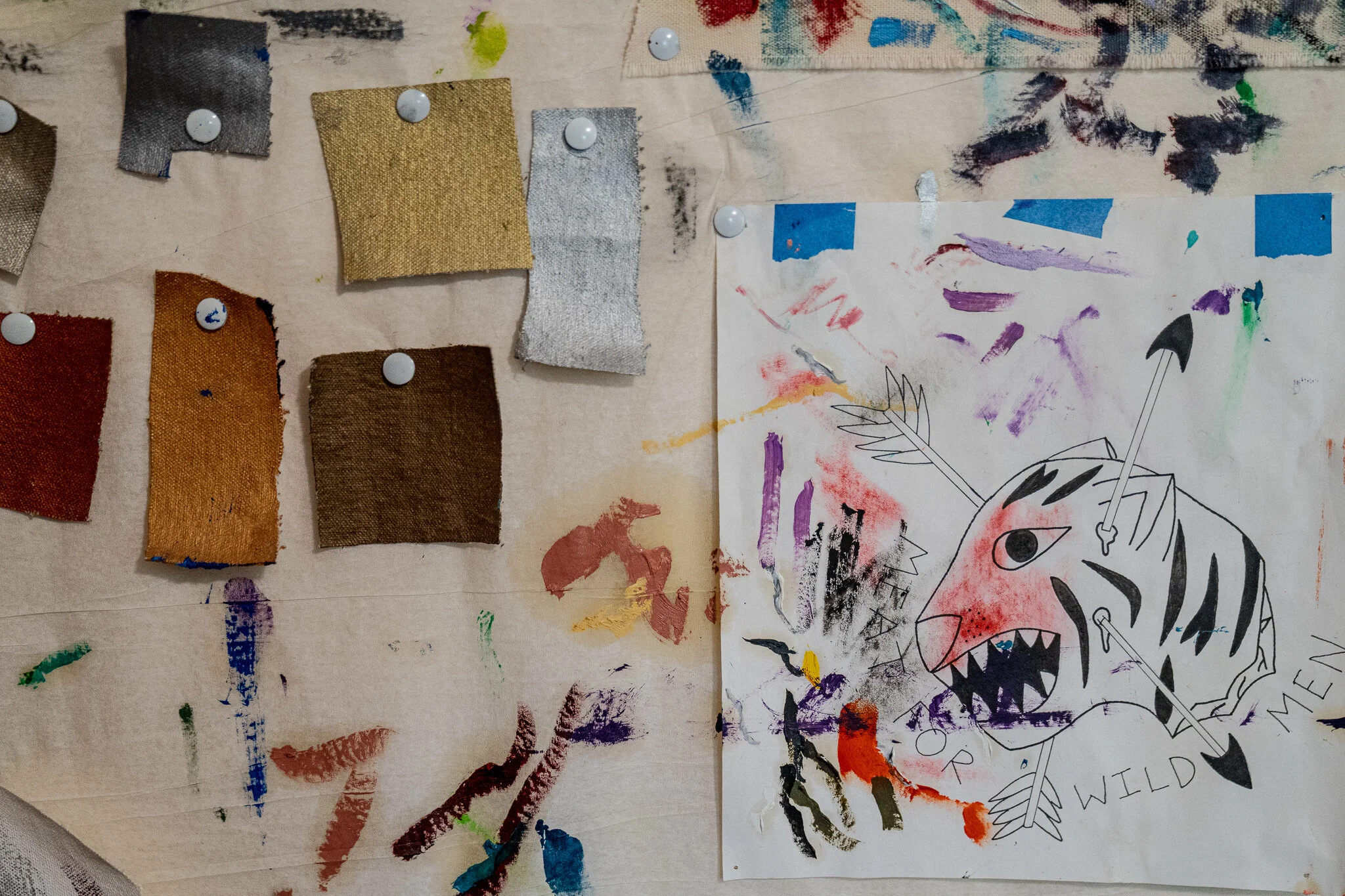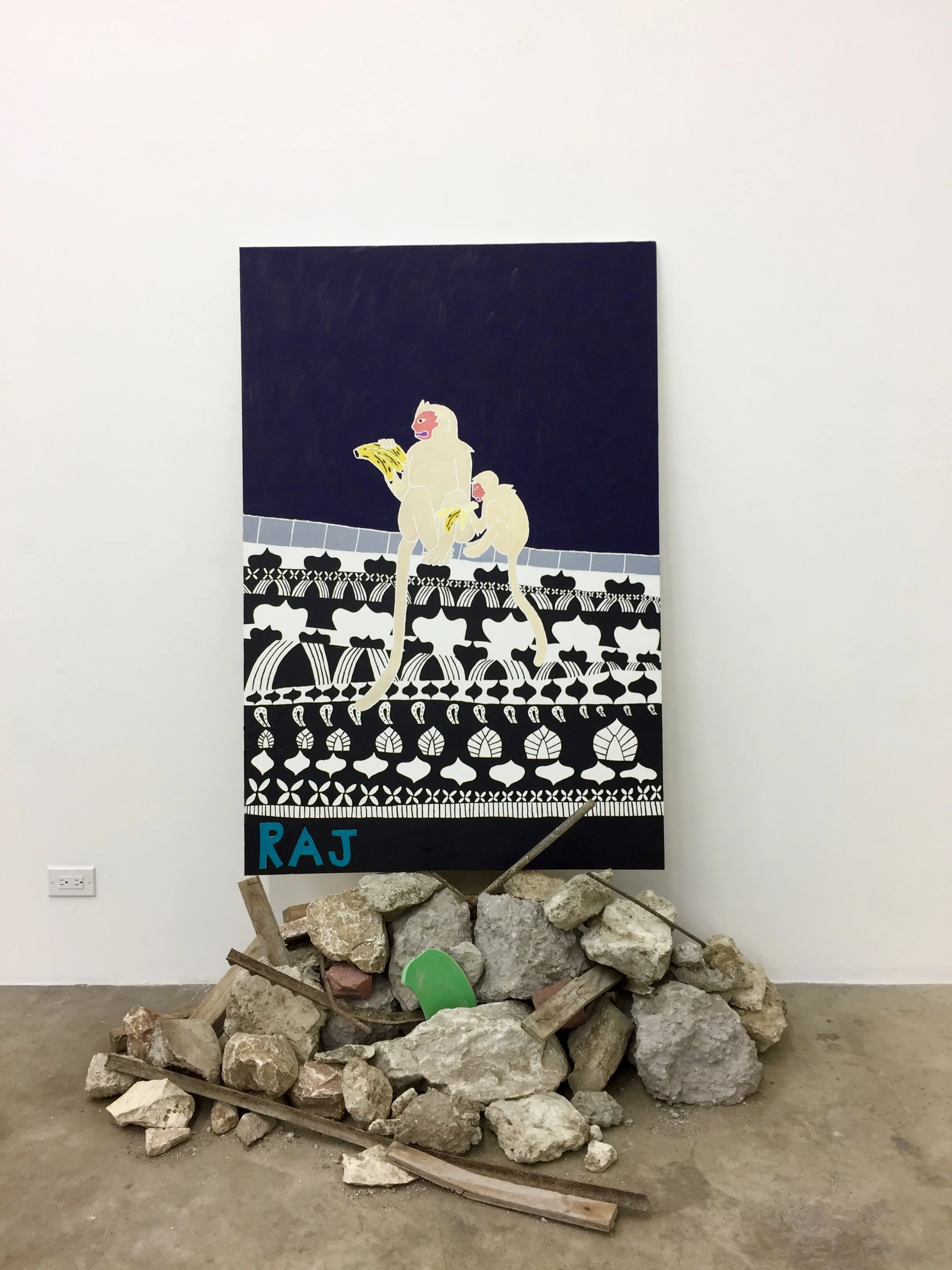Manik Raj Nakra: Crumbling Temples in the Jungle
By Hayley Labrum Morrison
After spotting Manik Raj Nakra’s piece at Martha’s Contemporary about a year ago, I have never forgotten it. The image existed in my mind as a cryptic, technically unique, beaded and tasseled (who could forget tassels!) image that was so visually different than anything else I had seen in Austin, I was surprised to learn the artist was local.
The space between the ancient world and the here-and-now is blurred in Manik’s striking paintings, drawings, and installations. His work views Indian iconography, colonial anachronisms, artifacts from early civilizations, and ceremonial folklore through an unapologetic modern lens that profoundly conveys the timeless human conflicts of egoism, lust, and self-sabotage. His use of wild colors, stark compositions, and "pop" sensibilities outline contemporarily relevant historical narratives of power, paranoia, dreams, and desire.
Hayley Labrum Morrison (HLM): How did you find your way to art?
Manik Raj Nakra (MRN): When I was in elementary school we had to bring something for Show & Tell that began with the first letter of our name. I spent the week leading up to my turn drawing ‘M’onsters, dozens of them. Some were several sheets of paper taped together. My teacher hung them in the classroom afterwards. A few days later, she handed them back to me in a box and said kids were getting scared. That’s how I got involved in art.
Samples from Manik’s ‘Wet Wall’.
HLM: Tell me about some of the materials you use. How do they convey your interests and concepts?
MRN: I started using oil paint because I thought it made paintings “look” expensive. Now I love everything else about it. I’ve only taken a twelfth grade art class that I almost failed so I don’t know anything about materials. But fucking up and figuring it out is fun for me. I love ancient art that hasn’t been restored much: Broken statues, cracked tiles, crumbling temples in the jungle, stuff like that. With metal leafing, I pour on my recipe of solvents and it makes all of these blues, greens, and oranges come out through oxidation. Some pieces are changing patina years later and I don’t know what color they will end up. I try to use a combination of materials that reminisce on the old artifacts I'm drawing on for inspiration but still feel of this time and place. They are a reminder, or maybe a warning, that history repeats itself.
Manik’s new Pencil and Charcoal Series.
HLM: What are your creative habits? What motivates you to work?
MRN: I work in the mornings and nights. Sometimes I like to start a lengthy studio session around midnight and go super late. There is a creative shift on the other side of midnight for sure. Lately, I listen to Velvet Underground, The Doors, and Sigur Ros live bootlegs really loud late at night too. The shittier sounding the better. I’ve got one I listen to that some fan made by literally jamming a cheap recorder into the back of Lou Reed’s guitar amp at a show in 1969. The singing and other instruments are barely audible and what results are these loud-as-fuck hallucinatory layers of feedback, crackles and pops, noise-y riffs and guitar buzz. Sounds like garbage. It’s awesome. I love the color choices I make when I listen to that one. It’s the Holy Grail of bootleg for me.
Manik in His Studio.
HLM: Love that reference to an ancient artifact (the Holy Grail) you slipped in there. The ancient world holds a significant place in your work. Is there any specific time period that captures your interest?
MRN: If I could go back and see any moment in human history in person, it would be the ancient city of Pompeii the day before and the day of the eruption of Mt. Vesuvius in 79 AD.
HLM: You also love the horror genre—What is it about Nosferatu that so affects you?
MRN: Nosferatu is the most romantic movie. The whole story of its making is too, like how it was ordered to be destroyed and a few surviving copies were discovered and then released. The exact original 1920 score is also shrouded with lots of mystery. My version (painting) recasts Nosferatu with jungle cats as vampires. There is this passionate relevance between violence and lust, imperialism and ecology, and power and ceremony in horror movies. Nosferatu alludes to the overwhelming power of romantic influence and humanity’s fascination with immortality. Life-changing film.
HLM: What are you working on now?
MRN: I've been making these nature scenes that will be viewed through palace windows. They are about isolation and looking out from our ivory towers or a castle in the clouds and witnessing nature be reborn and rejuvenate as it grows from upside down severed animal heads. The heads are upside down to symbolize self-sabotage and the mistakes of the past. I'm sticking literally thousands of Indian ceremonial bindis—third eyes—all over them. So, as you look out of the window, the painting also looks in with thousands of third eyes staring back at the viewer. It gives an existential feel to (the work).
HLM: Any artists you’ve been inspired by lately?
MRN: Robyn O’ Neil’s show “We the Masses” at the Modern Art Museum of Fort Worth has been occupying a large part of my brain for six months now.
HLM: Any collabs in the works?
MRN: Nah. I’m a lone wolf at the moment.
HLM: What are some of your favorite projects of the past?
MRN: My favorite art projects are usually just stuff I do for myself.
My first art show was at a rap show house party in 2005. We passed out flyers at this used CD store we frequented. My friend let me hang my art in the dining room and living room. It got rowdy and the cops came to bust it up. I felt cool for like the first time ever.
In 2019 I had a show in Houston. I last-minute secretly pinned this tiny 4x8” painting just one centimeter off the ground at the exit door of the gallery. I didn’t tell anyone and it wasn’t on the info sheet. It was the best piece in the show.
Another time I painted a coffin someone was gonna be buried in. That is insane to me. What an opportunity and an honor! I did it for free.
HLM: What non-art things are inspiring you lately?
MRN: The Black Lives Matter movement has been impactful since I first heard of it, but especially now in this worldwide moment, it's downright heroic. Black people are being really brave right now. These times inspire myself and others for sure.
HLM: What projects or exhibitions have you got coming up? Anything you want to learn?
MRN: I was scheduled to reopen Big Medium from quarantine with a solo show, but America wasn’t able to get its act together. It’ll be postponed to next year, I think. So (for now) I sit on my studio floor with xeroxes, scissors, and glue hand-stapling a zine. Gonna sell them for five bucks in the meantime, back to basics.
I want to learn to make stop-motion videos with found images I’ve archived from the internet. I want to learn to play an Elliot Smith song on my fiancé’s guitar.
HLM: Any career dreams you can share?
MRN: To make it into the best art institution this country has—the NBA baby. First Indian to ball.
Look out from your ivory tower onto Manik’s upcoming online show with grayDUCK gallery on Artsy later this month. Also be sure to follow him on Instagram for the latest on his zines and check out his past work (including our favorite “Black Paintings” series) on his website.
Read more conversations: Tsz Kam, Emma Hadzi Antich, Tamar Ettun.











